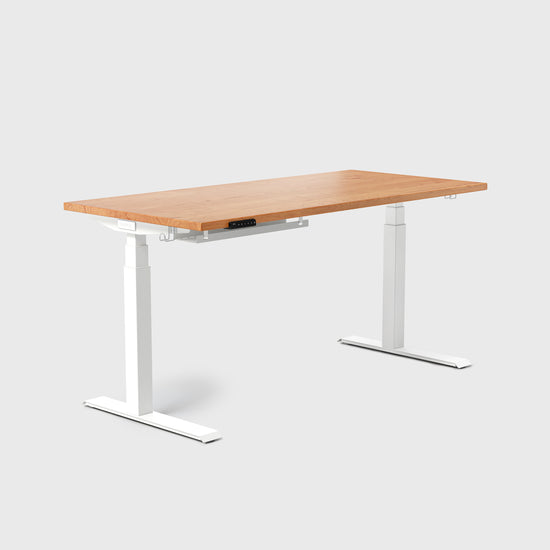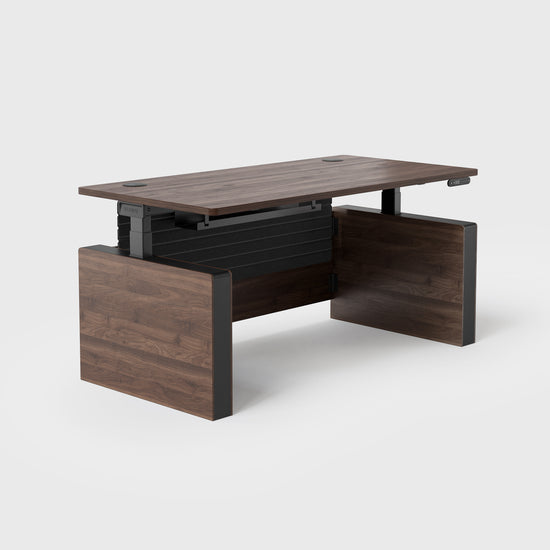
When setting up a workspace, people often focus on choosing the right chair. While an ergonomic chair is important for comfort and productivity, research shows that desk ergonomics—its height, depth, and overall setup—play an even greater role in long-term health and efficiency.
A Well-Designed Desk Matters More Than You Think
An improperly designed desk setup can contribute to a range of physical issues, including neck strain, back pain, and eye fatigue. While a good chair supports posture, your desk dictates how you position your hands, how much you lean forward, and how close you are to your screen. If the desk is too high, your shoulders remain elevated, causing tension. If it’s too low, you may slouch, leading to back strain over time. Adjustable standing desks have become an effective solution, allowing users to fine-tune their setup for optimal posture and reduced strain, improving both comfort and long-term health.
Desk Depth: A Critical but Overlooked Factor
When choosing a desk, many people focus on width to accommodate multiple monitors and accessories. However, depth (the distance from front to back) is just as important. It determines how far your screen sits from your eyes, directly impacting ergonomic health.
Why Does Desk Depth Matter?
According to the American Optometric Association, the ideal screen viewing distance is 50–75 cm (20–30 inches). If your screen is too close, it increases digital eye strain. If it’s too far, you may lean forward unconsciously, leading to poor posture.
For dual-monitor or large-screen users, desk depth becomes even more critical. A shallow desk forces screens too close to the eyes, increasing digital fatigue and making it difficult to maintain an upright posture. Research from the National Institute for Occupational Safety and Health (NIOSH) confirms that improper monitor positioning is a major contributor to neck and upper back pain.
Common Desk Depths and Their Limitations
- Most traditional desks are around 60 cm (24 inches) deep—suitable for basic setups but often insufficient for external monitors.
- If you use a monitor riser or external screen, the effective depth decreases, pushing the screen closer to your eyes and increasing the risk of eye strain.
- For users with monitor arms, multiple screens, or additional accessories, a desk depth of at least 75 cm (30 inches) offers better flexibility and ergonomic benefits.
Choosing the Right Desk Depth Based on Your Work Needs

Different professions require different desk depths. Here’s a guide to choosing the optimal depth based on your work setup:
75 cm (30 inches) or more – Recommended for
- Software developers & designers – Use multiple monitors, drawing tablets, or other accessories. A deeper desk prevents clutter and maintains an ergonomic viewing distance.
- Financial analysts & traders – Often rely on multi-screen setups and external input devices, making 80 cm or more ideal for comfortable positioning.
- Students & researchers – Need space for books, papers, and laptops. A 70–75 cm depth ensures a comfortable work environment.
60–70 cm (24–28 inches) – Suitable for
- Writers & editors – Typically use a single monitor or laptop. A standard 60 cm depth can work, but a larger surface provides more space for organizing materials.
- Casual laptop users & remote workers – If you primarily work on a laptop without extra screens, a 60 cm depth offers enough space while keeping the setup compact.
Investing in a Desk That Supports Your Well-Being
Choosing a desk isn’t just about style or available space—it’s about investing in long-term health and productivity. An ergonomically designed desk can help prevent common office-related health issues, including eye strain, neck pain, and chronic back discomfort.
When selecting a desk, consider:
- Your daily tasks – Do you use multiple screens, a monitor riser, or other accessories?
- Your workspace setup – Do you need flexibility for different work modes?
- Your long-term health – Does your desk depth allow for proper ergonomic posture?
Many desks on the market cater to different needs, including adjustable standing desks, deep workstations for multi-monitor users, and compact desks for minimalist setups. Some brands, such as VERNAL, incorporate these elements into their designs, offering options tailored for different work environments.

- Regular price
-
From
$899.99 - Regular price
-
$1,289.99 - Sale price
-
From
$899.99

- Regular price
-
From
$699.99 - Regular price
-
$899.99 - Sale price
-
From
$699.99



